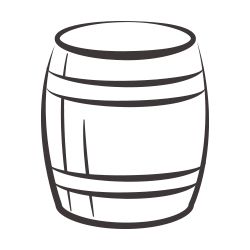Red fire and passion
LE SABBIE DELL'ETNA
Etna DOC
Nerello Mascalese, Nerello Cappuccio
Le Sabbie dell’Etna Rosso, together with its white variant, is the forerunner of Firriato’s many decades of wine production on Etna. Wines from the Cavanera Etnea Estate form part of the elite by birth and are dedicated to exclusivity. They are labels considered for and dedicated to the most demanding wine-lovers. Le Sabbie dell’Etna Rosso comes to the glass with a delicious and complex bouquet with notes of cinnamon, black pepper, blackcurrant and cherries in alcohol. Only the extraordinary terroir of Castiglione di Sicilia, on the slopes of Europe’s largest active volcano, could yield a wine with such great personality. The estate’s volcanic soils are distinguished by their high nutrient content of phosphorous, which determines the sugar content in the must; manganese, which increases the plants’ resistance to the cold; and iron, which contributes to the black grapes’ pigmentation, giving the native vine varieties of Nerello Mascalese and Nerello Cappuccio their bright ruby red colour.
Le Sabbie dell’Etna Rosso, together with its white variant, is the forerunner of Firriato’s many decades of wine production on Etna. Wines from the Cavanera Etnea Estate form part of the elite by birth and are dedicated to exclusivity. They are labels considered for and dedicated to the most demanding wine-lovers.
- Appellation: Etna DOC
- Vine: Nerello Cappuccio, Nerello Mascalese
- Terroir: mountain
- Soil: Loamy – sandy of volcanic origin, highly draining
- Exposure: north-east (700 mt. a.s.l)
Production Area
Tenuta di Cavanera Etnea

The north-eastern slope of Etna, where the Cavanera Estate is located, has predominantly sandy soil, composed of extremely fine particles that give it a loose structure, marked by its considerable fertility and high concentration of nutrients.

Le Sabbie dell'Etna Rosso
Etna and Nerello Mascalese, a thousand-year old union
The Spanish viceroyalty of Sicily coincided with Charles V ascension to the Spanish throne in 1516, and it is he who is thought to be responsible for the spread of Nerello Mascalese. Together with Niccolò Caracciolo, the Bishop of Catania, he decided to transform Piana di Mascali in Contea and one of the first steps he took was to place the land owned by the Curia at the disposal of the vine growers. Nerello vines, therefore, started to spread across the Etna countryside and today, thanks to their organoleptic properties and ageing capability, they are the emblem for oenology performed on the slopes of Etna.
LE SABBIE DELL'ETNA ROSSO
The characteristics of vintages
2020
The 2020 vintage on the north-eastern side of the Volcano was regular, thanks to a climatic trend that recorded temperatures below the seasonal average (the only exception being the first decade of August) and abundant rainfall that slightly postponed the ripening phase and collection.
2019
2019 vintage is generally affected by the colder and rainier climatic trends compared to the averages of recent years.Temperatures were below the seasonal average during the flowering period and favorable climatic conditions were also recorded during ripening. The vegetative development of the plants was optimal, with perfectly functioning foliage and a reduction in the average weight of the bunch which favored an increase in the average quality.
2018
The climatic trend of the first months of 2018 was characterized by mild winter and average temperatures recorded over spring season. On the contrary, summer was marked by rain and bad weather. Rainfall was more abundant and particularly in June, the wettest month of the last thirty years, according to regional averages. Despite rains in early summer, Etna vineyards benefited from favorable climatic conditions, preserving the grapes in the most delicate stages of fruit development and ripening.
2017
The 2017 vintage winery has been characterized by fresh autumn and winter fresh and by an almost dry spring. Since February, with the exception of some precipitation in April, it has practically never rained.Summer, starting from the month of June, was very hot, with high thermal values, which marked their peaks between the last days of July and the first ten days of August with maximum temperatures,
even 45-46 ° C.
2016
Grape harvest achieved extraordinary results on the Etna volcano. Cool summer with reduced rainfalls set ideal conditions for obtaining quality grapes. Grape harvest began about a week earlier than usual and ended about a week earlier on schedule, avoiding the rains of October. Although quantity production is along with vintage 2015, quality has increased, offering more aromatic whites with excellent freshness. Nerello Mascalese grapes have released bright colourful wines without any alcohol excess while the base wine used for the classic method presented higher level of malic acid compared to vintage 2015. Harvest period of Nerello Mascalese and Nerello Cappuccio grapes: second part of October
2015
The winter was hard with heavy rainfall, also the spring was very rainy with temperatures below the seasonal average, this has led to a budding more late. Excellent was the vegetative growth of the high temperatures of May and June have exploited for a splendid flowering followed by a good fruit set. The hailstorm that hit June 9 reported fortunately little damage limited to vegetation. A health standard the year was presented with great, with healthy grapes, without pests.
The heavy rains of August and the temperature lowering did think of a difficult harvest, instead they created a reservoir of water that allowed to arrive in September with a good vitality in plants. In general it was very interesting vintage with a very high standards.
.
2014
Weather conditions are crucial to produce quality grapes. After spring and beginning summer rains, temperatures gradually come to seasonal average with no heat peaks. Finally, we come back to typical Etna vintage. September rainfalls trigger concerns making us think about a difficult vintage. However , the prophetic picking month of October is clement, with sunny days and no rains enable to bring healthy grapes with well- balanced leaf surface/production ratio (1 square foot of leaf surface per 1 kilo of grapes), into the winery.
2013
The year showed to be fruitful. Either regarding the quantity, and definitely regarding the quality “very interesting wines regarding the aromatic profile” had been obtained. Because of the climate, the harvest lasted till the last week of October. The year 2013 gave a slower harvest and then a gradual maturation.
2012
The run of vines growing season, during the flowering and fruit setting, has been pretty regular. Anomalies during veraison and ripening phases were not present. The harvest of white, early varieties, has started earlier than the previous year. Lucifer, Charon and this summer’s other African anticyclones have been a blessing for the vintage, “an exceptional year regarding the quality”.
2011
The weather conditions were fairly stable, resulting in a winter with average temperatures and less rainfall compared to previous years. Rainfall was plentiful during the spring months, preparing the vines well as they went on to produce healthy grapes of optimum ripeness. However, the harvest, which was performed by hand during the middle and last third of October, recorded a drop in production of 15% due to reduced bunch size.
2010
The labourers of Mount Etna prepared to harvest the autochthonous Nerello Mascalese and Nerello Cappuccio grapes from the start of October. The climate in 2010 was distinguished by a winter with average temperatures and scarce rainfall and a mild and not very wet spring. The dry summer season hinted that the fruit may not match up to its usual level of perfection, but thanks to timely rainfalls at the end of September, the harvest did not fail to meet expectations.
2009
Bud break occurred later than in previous years thanks to the favourable weather conditions in 2009. Autumn was distinguished by fairly wintry weather and abundant rainfall, which was also frequent in the spring. The growth of the vines slowed down considerably during this first stage and then proceeded as normal in the very warm and humid summer months.
2007
Thanks to unstable weather conditions, with rainfall that was scarce in the winter and abundant in spring, 2007 was not an excellent year. This affected the production in terms of quantity, with a reduction of 35% compared to the previous year.
2008
It was a relatively good year, starting with favourable weather conditions for bud break, which occurred earlier than forecasted, slowing down towards the end in spring due to abundant rainfall, which affected plant growth whilst preserving the goodness.


LE SABBIE DELL'ETNA ROSSO
Awards
2019
James Suckling: 93 pts
I Vini Veronelli : 3 red stars
International Wine Report: 93 pts
WinesCritic: 91 pts
2018
Wine Spectator: 89 pts
James Suckling: 93 pts
2017
James suckling: 92 pts
Falstaff: 88 pts
Berebene 2019 del Gambero Rosso: Price Quality Award
2016
James Suckling: 92 pts
Wine International Report: 92 pts
2015
James Suckling: 91 pts
Vinous: 90 pts
Wine Enthusiast: 89 pts
2013
Robert Parker Wine Advocate: 89 pts
2012
Wine Spectator: 88 pts
Luigi Veronelli: 1 flower
2010
Robert Parker: 89 pts
2009
Annuario dei Migliori Vini Italiani: 88 pts- The best producer of the year
Luigi Veronelli: 3 red stars
2008
Robert Parker: 90 pts
Paired with
Beef tartare with seasonal vegetables pureed soup and Dijone mustard in grains
Prepare the vegetables for the garnish. Skip the carrots and courgettes along with the spring onion rings. Slice the tomato and rinse the mixed salad leaves. Keep aside


















